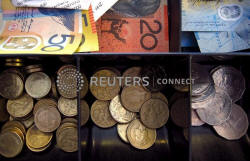Risk-sensitive currencies recover some losses; dollar
steadies
 Send a link to a friend
Send a link to a friend
 [June 15, 2020] LONDON
(Reuters) - The dollar steadied on Monday and commodity currencies
erased some losses as the "risk-off" sentiment which dominated overnight
trading eased somewhat. [June 15, 2020] LONDON
(Reuters) - The dollar steadied on Monday and commodity currencies
erased some losses as the "risk-off" sentiment which dominated overnight
trading eased somewhat.
Equity markets fell in early London trading, with many analysts citing
fears of a second wave of COVID-19 infections.
China re-introduced restrictions in some areas after Beijing reported
its biggest cluster of new infections since February.
In the United States, more than 25,000 new cases were reported on
Saturday alone.
Against a basket of currencies, the dollar rose overnight, gaining 0.4%
between 0440 GMT and 0700 GMT <=USD>. It then erased some gains, and was
at 97.12 at 1015 GMT.
Societe Generale FX strategist Kenneth Broux said the market had reacted
to news about rising coronavirus infections. Market consensus is that
the dollar's gains peaked in March, and traders are now pausing for
profit-taking, he said.

Commerzbank's head of FX and commodity research Ulrich Leuchtmann said
there had long been news of new infections, and the fact that other
safe-haven currencies did not strengthen suggested the dollar's rise was
more a product of its recent weakening.
"In my view it is all much more trivial. Following a pronounced period
of USD weakness it is now time for a correction and profit-taking,"
Leuchtmann said.
The Australian dollar fell to a 13-day low versus the dollar in early
London trading before erasing some losses to 0.6805 <AUD=D3>, down 0.7%.
The New Zealand dollar was down 0.4% <NZD=D3>.
The safe-haven Japanese yen held firm against the dollar and was little
changed from Friday's close at 107.36 <JPY=EBS>.
Industrial output in China rose for a second consecutive month in May,
but the rise was smaller than expected, suggesting the world's
second-biggest economy is struggling to get back on track after
containing the coronavirus.
[to top of second column] |

A U.S. Dollar banknote is seen in this illustration taken May 26,
2020. REUTERS/Dado Ruvic/Illustration

"More evidence of economic recovery in China is a positive development for the
global economy, although market participants understandably remain on edge over
the risk of further disruption from second waves," MUFG currency analyst Lee
Hardman wrote in a note to clients.
European countries eased some border controls on Monday following coronavirus
lockdowns, a move that could help salvage part of the summer season for Europe's
battered travel and tourism industry.
The euro was broadly flat against the dollar at $1.1251 <EUR=EBS>.
Financial markets may be in the process of repricing the world's most-traded
exchange rate, with derivative contracts suggesting the euro could surge by as
much as 6% against the dollar to $1.20 by year-end.
As oil prices fell, the Norwegian crown hit a 4-week low versus the euro. It
then erased some losses to stand at 10.9145 by 1037 GMT <EURNOK=D3>, down around
0.5% on the day.
The Bank of England, Swiss National Bank and Norges Bank will all hold meetings
on Thursday and are expected to keep their main policy rates unchanged.
(Reporting by Elizabeth Howcroft; Editing by Pravin Char and Jan Harvey)
[© 2020 Thomson Reuters. All rights
reserved.] Copyright 2020 Reuters. All rights reserved. This material may not be published,
broadcast, rewritten or redistributed.
Thompson Reuters is solely responsible for this content.
 |